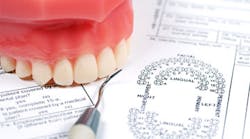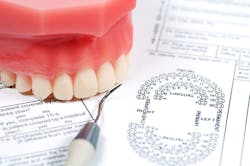Thursday Troubleshooter: Dental practice has trouble charging if insurance won’t pay
Nearly everyone has problems and concerns on the job, and sometimes you're just too close to a situation to solve something yourself. Share your concerns with Team Troubleshooter, and the experts will examine the issues and provide guidance. Send questions to [email protected].
________________________________________________________________________________________________________________________________
QUESTION: I have practiced dental hygiene for 17 years and it seems my office still has trouble charging out for certain procedures that are done because insurance won’t pay. For instance, a patient has moderate stain that takes 30-plus minutes to remove but no bone loss or increased probe depths. Even though it takes more than an hour to complete the cleaning, we still charge for a prophy. What is the best way to charge for the time we spend working with patients even if they don’t have perio disease? Thank you!
ANSWER FROM PATTI DIGANGI, RDH, MS, author of DentalCodeology:
Congratulations for bringing this dilemma forward. Many practices and caring practitioners like you are having this same problem.
Let’s look at the easy part first. Whether or not insurance payment is expected should not be part of the reason a necessary or requested procedure is charged out or not. What if there is coverage under some policies? Does it follow then that if there is coverage, a fee is charged, but if there is not coverage, it is not charged? What if the patient is private pay? Is it charged then?
This inconsistency not only seems problematic but it could lead to possible fraud. Further, there is a fairness and ethics issue here. The bottom line is that all care should be coded if an accurate code exists. Codes are not for dental benefit payment only, they are also important metrics.
Fees are a separate issue. A practice can choose to charge whatever fees they want. Practice fees should be based on the cost of doing business plus a reasonable profit. With annual cost-of-living inflation, your cost of doing business increased in 2016.
Routine analysis of cost helps to ensure that your practice is functioning efficiently and effectively. A practice can have a sliding scale of fees based on time. In the medical coding world, time is often a parameter for an accurate code. CDT 2017 has some codes that are time-specific.
The next part is the diagnosis of periodontal disease. Periodontal disease is not limited to situations where there is bone loss. The new D4346 code for gingival inflammation finally codifies this.
Traditionally, the most common procedure code submitted is the prophylaxis code. The majority of care rendered under this code has been treatment, not prevention, yet there were no codes to accurately describe the care rendered. Dental hygienists everywhere have long known there is a category of care between what we routinely treat with prophylaxis and SRP. This care has all been thrown in the catch basin of prophy codes.
In the real world of clinical practice this has led to a gap in the codes and changes in dental professionals’ thinking. We typically don’t consider a patient’s condition of periodontal disease serious until there is bone loss. This is somewhat akin to knowing someone has high blood pressure but we don’t consider it a disease until there’s a heart attack.
Thanks to the D4346 code we can finally treat gingivitis after decades of merely dumping gingival inflammation into the same category as health. This new code can potentially close the loop and elevate our standard of care.
With increasing research pointing to the connection between oral disease and medical conditions, the timing for the code is perfect. Early recognition ensures earlier intervention and disease prevention.
In my opinion, and this is based on supposition only, the diagnosis could have readily been missed. What was the bone height? My guess is it was not documented. I have yet to see a perio chart that had the space allocated for documentation, and we know that is not all that is needed for a periodontal disease diagnosis.
Diagnosis is based on clinical attachment loss (CAL), not just pockets. CAL is determined by pocket/sulcus depth plus recession/bone loss measurement added together.
Finally, I will challenge your thinking. I had to ask myself these same questions about stain. Is stain pathogenic? No. Is stain a cosmetic consideration? Absolutely! Should we spend excessive time removing stain? That’s a tougher question.
We often don’t know the derivation of the multi-factorial reasons for the staining. Our dental hygiene education taught us, we must remove all of it. Nearly every RDH has that voice in this or her head, conscious or not.
Before I ask a final question, I need to say, I do not advocate leaving anything behind. Here’s a question I had to ask myself. As an example, I have a patient who is a home health respiratory therapist and friend, whose had stain due to smoking, and cigarette stain was definitely a negative for her job. Here’s the tough question—did I tacitly encourage her to continue her habit by removing the stain?
RECENT TROUBLESHOOTERS
Is practice required to abide by mother’s whitening demands for 15-year-old?
Practice takes back promises on PTO, insurance, and holidays
Lid on or off the ultrasonic cleaner while running?
Don't be shy! If YOU have a tough issue in your dental office that you would like addressed, send it to [email protected] for the experts to answer. Remember, you'll be helping others who share the same issue. Responses will come from various dental consultants, as well as other experts in the areas of human resources, coding, front office management, and more. These folks will assist dental professionals with their various issues on DentistryIQ because they're very familiar with the tough challenges day-to-day practice can bring.
All inquiries will be answered anonymously each Thursday here on DIQ.
For the most current practice management headlines, click here.
For the most current dental headlines, click here.
About the Author
Team Troubleshooter
This column features questions from everyday people who work in dental practices, who have issues they would like addressed by the experts. It no longer runs regularly, but the questions sent in the past still apply to dental practices today. Search "Troubleshooter" on DentistryIQ to read more.

